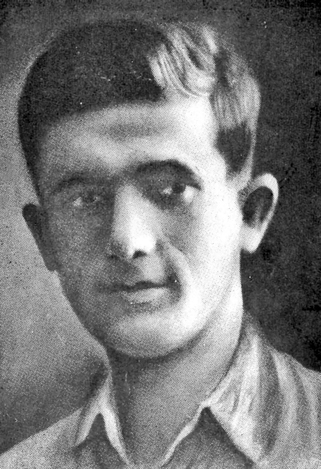Mordechai Anielewicz (1919–1943)
Leader of the Ha-Shomer Ha-Tzair movement, commander of the Jewish Combat Organization, hero and a leader of the Warsaw Ghetto Uprising.
Mordechai Anielewicz was born in 1919 in Wyszków, near Warsaw. His mother, Tzirel Zaldman, came from Wyszków, while his father Abraham‘s family was relocated from Galicia during World War I. Toward the end of that war, Mordechai’s parents moved to Warsaw, settling at 13 Solec Street in the Powiśle district. They also opened a grocery store on the nearby Tamka Street. In 1919, during the Polish-Soviet War, Anielewicz’s father was conscripted into the Polish Army.
Mordechai had three younger siblings—sisters Chava and Frida, and a brother, Pinchas. The family’s modest income from the grocery store was insufficient to sustain them, forcing the children to attend school often hungry and without their own textbooks, relying instead on the assistance of more affluent classmates.

Mordechaj Anielewicz | Domena publiczna
From an early age, Mordechai stood out among his peers. One of his teachers once told his mother: “Your son has talent and potential—you may one day be proud of him.”
Although he was not the top student in every subject, he excelled in history, foreign languages, and mathematics—fields that deeply interested him. He continued his education at a private Hebrew-language boys’ gymnasium on Nalewki Street, where his natural leadership skills began to emerge. He chaired the school committee, gave speeches at ceremonies on behalf of the school, and organized demonstrations and strikes. While generally well-liked, he also had critics, he was strict and demanding when needed. From the age of 14, he tutored others to help support his family financially.
In 1934, he joined the left-wing Zionist youth organization Ha-Shomer Ha-Tzair and quickly became one of its active members and youth educators. By 1937, he was part of the leadership of the Warsaw branch of Ha-Shomer, and his debut speech in Hebrew, delivered with impeccable accent, made a strong impression on fellow members.
Toward the end of his schooling, he dedicated more time to ideological and political literature than to formal studies. Growing up as a young Jew in the 1930s, he was deeply disturbed by the rise of fascism in Europe and escalating antisemitism.
In the summer of 1937, responding to a call from communist youth for the creation of a joint anti-fascist front, Anielewicz co-organized self-defense groups against antisemitic attacks. “With his close cooperation, youth groups patrolled the area around the Saxon Garden every evening to guard against assaults by Falanga thugs,” wrote Szymon Bruss in A Remembrance of Mordechai Anielewicz.
Around this time, he also met Mira Fuchrer, who would later become his life partner and comrade in arms. Before the war, he also established valuable contacts with the Polish Scouting Association (ZHP), which proved important for Ha-Shomer after the German invasion.
Following the outbreak of war in 1939, Anielewicz, like many leaders of Jewish political and social organizations, headed east. He attempted to organize an escape route for Jewish youth to Palestine via the Polish-Romanian border in the early days of the war. This was briefly possible before Soviet forces consolidated their control and sealed the borders. He was detained at Kuty by Soviet border guards while trying to cross and, after a short arrest, returned to Warsaw, then moved to Vilnius, where Mira and other friends were based. It was assumed that Vilnius might become a hub for international Jewish organizations, with a sea route to the Land of Israel potentially operating from Baltic ports. However, in early 1940, Ha-Shomer Ha-Tzair decided that its leadership should return to German-occupied Poland to support Jewish youth during these trying times. Anielewicz and Mira returned to Warsaw, where he became involved in clandestine activity within the Warsaw Ghetto starting in November 1940.
He quickly engaged in underground resistance work, both in Warsaw and other parts of occupied Poland. Traveling illegally, he delivered underground press to regions such as Zagłębie and Kielce. He co-edited the clandestine publication Neged Ha-Zerem (“Against the Current”) and organized educational and cultural circles that brought together hundreds of young Jews. Much of this activity was centered in the Ha-Shomer kibbutz on 23 Nalewki Street. Between the summer of 1941 and 1942, together with Mira Fuchrer, Tova Frenkel, and Szmuel Breslaw, he operated a secret radio monitoring station. They intercepted news from foreign broadcasts and compiled bulletins that were used by other underground publications. In this way, ghetto residents—cut off from outside information—could learn about global events.
Historian Emanuel Ringelblum wrote of Anielewicz:
“Comrade Mordechai, modest and quiet, I only saw him once as commander of Ha-Shomer. It was in the winter of 1941/1942… About 500 shomrim and shomrot gathered in the hall. The evening was of a very high standard… At that event, I realized how much love, respect, and devotion the members of Ha-Shomer had for Comrade Mordechai. The same affection accompanied him as commander of the Combat Organization. Power never went to his head. He remained as modest as ever.”
Long before the formation of the Jewish Combat Organization (ŻOB), Anielewicz called for armed self-defense:
“If the horrifying events of Vilnius or Chełmno happen again—there must be no passivity. If there is nothing left to lose, one must at least die with dignity, so that the crimes of the Nazi beast do not pass unnoticed, and so that future generations can bring justice to the criminals.”
In March 1942, he co-founded the Anti-Fascist Bloc, uniting leftist Zionists and Jewish communists. In June, he traveled on behalf of Ha-Shomer to the Zagłębie region, where he organized a local underground newspaper, encouraged local Jews to form self-defense groups, and helped establish resistance structures. “He had more than charisma—he had extraordinary strength. He had a profound impact on people,” recalled Szmul Ron, a fellow activist.
During the mass deportations of Jews from the Warsaw Ghetto to Treblinka in the summer of 1942 (Great Liquidation Action), Anielewicz was not in the city. Upon his return in September, he took part in rebuilding the Jewish Combat Organization (ZOB), joined its leadership, and was appointed commander in November.
Icchak Cukierman, deputy commander, recalled:
“Anielewicz wanted to be the commander of the ŻOB, and he deserved it in every way. He believed in himself and had ambition… He had leadership skills, could make quick decisions, and take responsibility. He proposed himself for the role during a staff meeting, and I readily agreed, even though I had previously been considered for the position. In the ŻOB, no decisions were made without meetings and discussion anyway.”
On January 18, 1943, as the second major deportation began, Anielewicz led the first armed resistance against the Germans in the ghetto. His unit, armed only with pistols and grenades, blended into a crowd of Jews being marched to the Umschlagplatz. At a pre-arranged signal on the corner of Miła and Zamenhofa Streets, they broke formation and opened fire on the German escort. Anielewicz participated directly—when he ran out of ammunition, he seized a weapon from a German soldier and continued the fight. He survived only thanks to the quick action of a comrade who pulled him into a doorway.
The January action was a turning point. Though most of the fighters were killed, several Germans were also killed, and dozens of Jews managed to escape. It was the first instance of organized, armed resistance in the Warsaw Ghetto, which stunned the Nazi occupiers and inspired hope among the ghetto’s residents. After this action, the ŻOB gained broader support, and Anielewicz became a symbol of unyielding defiance.
On April 19, 1943, the Germans surrounded the Warsaw Ghetto to begin its final liquidation. The Jews launched an armed uprising. Anielewicz directed the fighting from the ŻOB headquarters at 29 Miła Street. The initial resistance completely surprised the Germans. After two days of intense fighting, during which German forces were twice forced to retreat, Anielewicz sent a message on April 21 to the Jewish Coordinating Committee:
“The fighters are performing wonderfully. Morale in the fighting units is excellent. Our casualties are relatively light. We lack ammunition. We will fight to the last breath.”
In the following days, the situation deteriorated. The Germans began systematically burning and blowing up buildings to kill fighters through suffocation or building collapse. In response, Anielewicz, Mira Fuchrer, and members of the ŻOB command moved to a bunker at 18 Miła Street, originally built by smugglers from the Jewish underworld. It became the uprising’s main base of resistance.
On April 23, Anielewicz wrote from the bunker to Yitzhak Zuckerman, who was on the Aryan side trying to procure weapons:
“Something has happened that exceeds our wildest dreams: the Germans retreated from the ghetto twice… From tonight, we’re switching to partisan activity. Three of our units will go leave the ghetto tonight. They have two tasks: armed reconnaissance and obtaining weapons… Only individuals will survive this. Everyone else will perish sooner or later. That fate is sealed. In almost all shelters where thousands are hiding, you cannot even light a candle—there is no air… What matters most is that the dream of my life has come true. I lived to see Jewish self-defense in the ghetto—in all its grandeur and glory.”
On May 8, the Germans surrounded the bunker at 18 Miła Street. About 200 civilians hiding in the bunker surrendered, but the command staff and around 120 fighters did not. Roughly 100 died from gas poisoning or committed suicide. A few managed to escape.
To this day, the exact circumstances of Anielewicz’s death remain unknown. According to some accounts, he and Mira took their own lives. Others, including testimony from Tosia Altman, suggest he tried to save himself and others until the very end. Hela Rufeisen later repeated Altman’s account:
“Mordechai Anielewicz was against suicide. He believed that if there was even the slightest chance of surviving until evening, it should be taken. He said that during the First World War, soldiers protected themselves from gas by covering their faces with wet cloths. That’s what Mordechai, Mira, and others tried to do to help those around them survive.”
Although the Germans brutally suppressed the uprising, the Jewish fighters did not voluntarily surrender into the hands of the Nazis —and in that sense, they were not defeated.
Mordechai Anielewicz was posthumously awarded the Cross of Valour by the Polish government in 1944, the Cross of Grunwald (3rd Class) in 1945, and the Grand Cross of the Order of Polonia Restituta in 2023.
Bibliography:
- Ringelblum Archive, vol. 22: The Warsaw Ghetto Press: News from Radio Monitoring, Warsaw 2016
- Ringelblum Archive, vol. 29a: Writings of Emanuel Ringelblum from the Bunker, Warsaw 2018.
- Ringelblum Archive, vol. 18: The Warsaw Ghetto Press: Hashomer Hatzair, Warsaw 2023.
- Bauer Yehuda, „Powstanie w getcie warszawskim. Nowe spojrzenie” [w:] „Zagłada Żydów. Studia i Materiały”, nr 14 , 2018
- Bernard Mark, “The Warsaw Ghetto Uprising”, Warsaw 1963.
- Bruss S., „Wspomnienie o M. Anielewiczu, Spuścizna Bernarda Marka S/333”, AZIH.
- Cukierman Izzchak, „A Surplus of Memory”, Warsaw 2020.
- Grupińska Anka, “Ciągle po Kole”, Wołowiec 2013.
- Gutman Israel, “Mered hanetsurim: Mordekhai Anilevits wemilhemet geto warsza”, Jerusalem 2013.
- Rufeisen-Schupper Hela, “Pożegnanie Miłej 18”, Krakow 1996.

